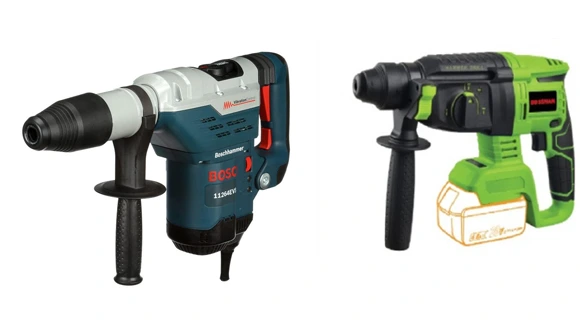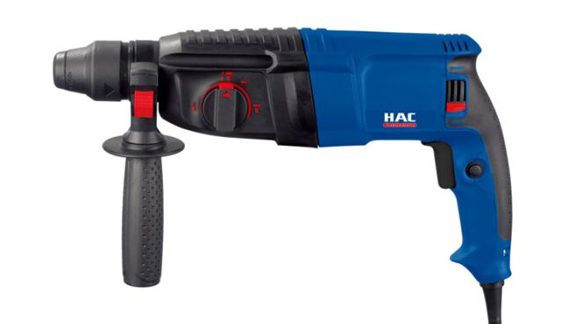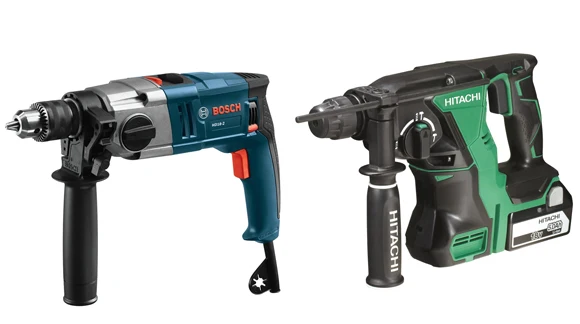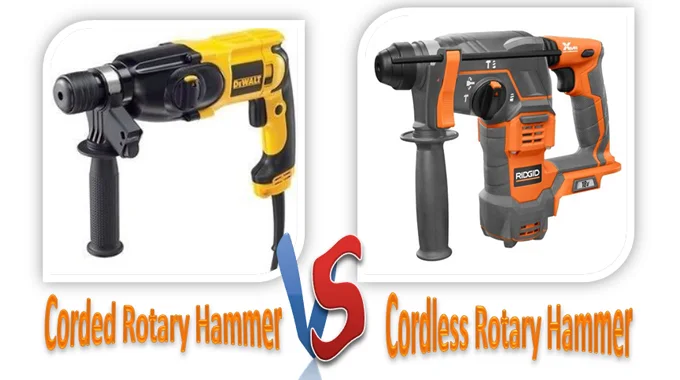Last Updated on January 23, 2023
It is pretty straightforward what are the main differences between corded and cordless rotary hammers. But a simple answer “with and without” a cord will not explain which one to use and which one to avoid in specific situations.
People have different purposes for using a rotary hammer. You can be a DIY woodworking hobby person or a commercial expert. Your working range must have a level and limit.
Whether you are working on your hobby or professional work, there is always a factor of frequency. So, you cannot just get one and make an efficient decision. You must clearly understand the significant differences between corded and cordless rotary hammers.
Corded vs Cordless Rotary Hammer: Advantages and Disadvantages

There are several factors to consider when choosing a rotary hammer drill. It’s important to choose the one that best suits your needs is important as each type of drill has its own advantages and disadvantages.
Advantages of using a corded rotary hammer drill
Corded rotary hammer drills offer a number of advantages over their cordless counterparts. These are 10 reasons why you should use a cordless rotary drill:
- First, they are more powerful, meaning that they can handle tougher jobs than cordless models
- Second, they don’t require batteries, so you’ll never be left without power during the working time of a project.
- Third, they are typically more compact and lightweight than cordless models, making them easier to maneuver and use for extended periods of time.
- Fourth, they come with a variety of features that make them more versatile, such as variable speed settings and different chuck sizes.
- Fifth, they have a longer lifespan than cordless drills, so you won’t have to replace them as often.
- Sixth, they tend to be less expensive than cordless models.
- Seventh, they produce less vibration than cordless drills, making them more comfortable to use.
- Eighth, they don’t produce fumes or emissions, making them more environmentally friendly.
- Ninth, you can use them with a variety of accessories to expand their capabilities. Offers all of these advantages and more, making them the ideal choice.
Advantages of using a cordless rotary hammer drill
A cordless hammer drill can be a great addition to any toolbox. The following are 8 benefits of using cordless rotary hammers:
- More portable than corded models. This indicates that they can be taken with you on the go without the need for a power outlet.
- Typically less expensive than corded models.
- some models come with built-in LED lights for better visibility
- Cordless rotary hammer drills are very versatile. Drilling holes, driving screws, and chiseling can be accomplished using these tools.
- Offer more freedom of movement than corded models. This allows you to work in tight spaces and reach difficult angles.
- Less likely to overheat than corded models. Ensures that they can be used for prolonged periods without the risk of damage to the motor.
- Convenient to use – Since cordless hammers require a battery, they are a bit more convenient to use than corded models. This is especially true if you’re working in an area where there is no power outlet.
Corded Rotary Hammer Drills Have Their Own Disadvantages
A corded drill is a useful tool for a variety of drilling and demolition projects. However, there are also some disadvantages to using this type of drill.
- Limited by the length of the power cord.
- Not as portable as a cordless model. This means that you will need to have an extension cord with you when you use it, which can be a hassle.
- Corded hammer drills can be more expensive than cordless models.
- They also tend to be heavier and bulkier, which can make them difficult to handle.
- Require more maintenance than cordless models. The cords can become frayed or damaged, and the brushes inside the drill need to be replaced periodically.
- Can produce a lot of vibration, which can be uncomfortable for your hands and arms.
- They also produce a lot of noise, which can be irritating if you are not wearing ear protection.
- Corded rotary hammer drills generate heat, making them potentially hazardous if not handled properly.
- The cords can also pose a trip hazard if they are not properly secured.
- Are not as versatile as cordless models because they cannot be used in areas with no power outlet.
Negative Aspects of Having a Cordless Hammer
- Limited battery life: most cordless rotary hammer drills will only run for around 20 minutes on a full charge, which can be frustrating if you’re trying to complete a big project.
- Heavier than corded models: since batteries are needed to be carried , cordless rotary hammer drills tend to be heavier than their corded counterparts. This can make them more difficult to use for a longer time frame.
- More expensive: since they’re not as common as corded models, they tend to be more expensive. This can make them out of reach for some homeowners.
- Tend to be less powerful than corded models. This makes them not so ideal for heavy-duty applications.
- Lower speed and power: while cordless rotary hammer drills have come a long way in recent years, they still can’t match the speed and power of their corded counterparts. This can make them less effective for certain tasks.
- Requires special batteries: most cordless drills require special batteries that can be expensive and difficult to find. This can be a major inconvenience if your drill runs out of juice in the middle of a project.
How does a Corded Rotary Hammer work

A corded rotary hammer is a heavy duty tool that uses a rotating drill bit to bore holes in concrete, brick, or mortar. It consists of four main parts: the body, the motor, the chuck, and the rotating drill bit. The body of the rotary hammer is typically made of metal or plastic and houses the motor.
The motor is responsible for providing the power to rotate the drill bit. The chuck is a clamping device that holds the drill bit in place, and the drill bit is the cutting implement that actually bores through the material.
When in use, the operator holds the rotary hammer in one hand and presses the trigger with the other. This activates the motor, which spins the drill bit at high speed. The operator then applies pressure to the tip of the drill bit, causing it to rotate and bore through the material.
Corded rotary hammers are typically used for larger projects where an electric outlet is readily available. They are also more powerful than their cordless counterparts and can therefore handle tougher drilling applications.
Corded rotary hammer drills are available in a variety of sizes and power levels, so you can find one that’s right for your needs. With the right tool, you can get the job done quickly and easily. They are more powerful than cordless models and are typically used for heavy-duty drilling applications.
How does a Cordless Rotary Hammer work
The working mechanism of a cordless rotary hammer is similar to that of a hammer drill, with the exception that it has a rotating chuck that rotates the drill bits at a higher speed. The hammering action of the drill provides both percussion and rotation, making it ideal for drilling large holes or breaking up tough materials.
The power and speed of the machine can be controlled using a trigger, and most models also have a reverse switch for removing fasteners or clearing jams. Cordless rotary hammers are powered by batteries, making them much more portable than their corded counterparts.
A cordless rotary hammer, also known as a rotary impact drill, is a tool that uses a hammering action to drill holes in concrete and other hard materials. When choosing a cordless rotary hammer, it is important to consider the weight and size of the machine, as well as its battery life and power output.
Component Similarities Between a Corded and Cordless Rotary Hammer

Though cordless and a corded rotary hammer may seem like two very different tools, they actually have quite a bit in common.
- Both types of rotaries are power tools that use a spinning cutting head to drill holes or drive screws and nails.
- They are also both designed with an ergonomic handle that helps to reduce fatigue during extended use.
- Have steel drill bits that can be replaced as needed. The speed of both types of rotaries can be adjusted to suit the task at hand.
- Both have carbide-tipped chisels.
- Both have rotating pistons that create impact force.
- Both have gears that transfer power from the motor to the drill bit.
- Both use SDS (slotted disciplines system) chucks to hold drilling bits steady.
- Both can be fitted with dust extraction attachments.
- Both are available in different sizes and weights.
- Both require regular maintenance (such as lubricating the gears).
- Both come with a case or bag for storage and transportation.
Recommended Article To Read: What is the lifespan of Martinez and Stiletto Hammers?
Component Differences Between Cordless And Corded Rotary Hammer
For many home improvement projects, a corded or cordless rotary hammer is an essential tool. There are also some key differences between these two types of tools that should be considered.
- Battery pack – Corded rotaries are powered by an electrical outlet, while cordless rotaries rely on a battery pack.
- Power connection – A corded rotary hammer must be plugged into an electrical outlet, while a cordless model runs on batteries. This means that a cordless hammer is more portable, but it also may not have as much power as a corded model.
FAQs
1. Why Do Some People Prefer Corded Rotary Hammers?
Many people choose corded rotary hammers because they offer a number of significant advantages over cordless hammers. One of the main benefits is that they are much more powerful. This means that they can deal with tougher jobs, like breaking through concrete or masonry.
Corded rotary hammers also tend to be more durable than cordless models, so they can stand up to heavy use without breaking down. And because they are powered by cords, they don’t run out of battery power mid-job.
For these reasons, corded rotary hammers are often the tool of choice for professional contractors and serious do-it-yourselfers.
2. What Type of Impact Energy Is Produced by Cordless Drill?
This impact energy is created when the drill spins a bit or impacts the driver at high speed and then strikes it against the work surface.
The impact of the driver against the work surface creates a shock wave that travels through the drill bit or impact driver and into the workpiece. This shock wave is what produces the hole in the workpiece.
The amount of impact energy produced by a cordless drill depends on the size and weight of the drill, the speed at which it is operated, and the type of impact driver used.
3. Are Cordless Hammer Drills Better for Home Use?
Cordless hammer drills offer many advantages over their corded counterparts, making them ideal for home use. Cordless drills are much more portable, allowing you to take them wherever you need to go. They’re much easier to use since you don’t have to worry about tangled cords or tripping over them.
More versatile because you can use them for both drilling and driving screws. They’re quieter, so you won’t disturb your family or neighbors while you’re working.
Don’t produce as much vibration and fumes, so your hands won’t get as tired, and you can use them in well-ventilated areas without worrying about inhaling toxic gasses. Easier to maintain because there are no cords to clean or replace.
Finally, cordless drills are environmentally friendly because they don’t produce any emissions. All of these factors make cordless hammer drills the best choice for home use.
Conclusion
When it comes to choosing either a corded vs cordless rotary hammer drill, there are a few factors to consider. One of the most important is whether you need a corded or cordless model. Corded drills offer more power and are ideal for heavy-duty projects, also offer more flexibility, but they may not have enough power for some jobs.
They can be cumbersome to use, and you may need an extension cord to reach your work area. Another factor to consider is the dimension and mass of the drill. A heavier drill will be more difficult to handle, but it will also be more powerful. Some drills come with dust-collection systems or different speed settings.
Finally, think about the features you need. Choose the features that best fit your needs to help you complete your projects successfully.



